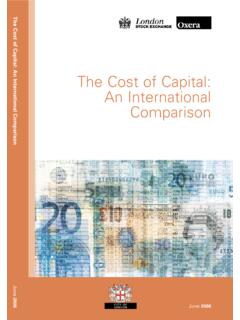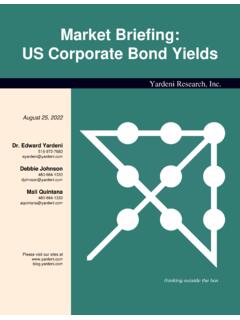Transcription of Probability of Default Ratings and Loss Given ... - CARE
1 Rating MethodologyProbability of Default Ratings and Loss Given Default Assessments for Non-Financial Speculative-Grade corporate Obligors in the United States and CanadaSummary Moody's expected loss (EL) based security Ratings and corporate family Ratings (CFRs) are supplemented with lossgiven Default (LGD) assessments on speculative grade loans, bonds, and preferred stocks, as well as Probability ofdefault Ratings (PDRs) on speculative grade corporate families for issuers domiciled in the US and Canada. ThisSpecial Comment outlines Moody's methodology for applying LGD and PDRs to this issuer group.
2 PDRs will rank order speculative grade corporate families by their relative likelihood of Default , irrespective of theexpected LGD rates on their defaulted instruments. PDRs will also alert investors to situations in which twocorporate families with the same CFR (and therefore the same EL rates) have different probabilities of Default anddifferent average expected LGD rates across their liabilities. LGD assessments will evaluate expected loss severity rates for loans, bonds, and preferred stocks.
3 LGDassessments will be expressed through a six point symbol system that orders expected loss severity from lowest tohighest. In addition, the whole percent point estimate for each rated liability, though subject to considerableuncertainty, will be made available by Moody's. The methodology used to derive the expected LGD rates underlying the LGD assessments on individualinstruments will be a function of the Probability distribution of different potential outcomes for the company'sfirm-wide recovery rates at Default , its expected liability structure at Default , and the expected security and priorityof those claims in bankruptcy.
4 While this Rating Methodology provides a broad overview of Moody's approach toLGD assessments and PDRs, a subsequent Special Comment will provide greater detail on the priority of claimanalysis used in the methodology. Implementation of the LGD rating methodology is not expected to affect existing CFRs. However, issue ratingsmay be affected to the extent that implementation of this methodology alters the LGD assumptions embedded incurrent Ratings . As suggested by previous Moody's research that showed realized credit losses on loans havetended to be lower than loss rates on similarly rated bonds, application of a rigorous estimation model for LGDrates will lead to higher Ratings on a large number of corporate loans.
5 Bond rating changes are expected to bemore balanced and less numerous. LGD assessments will be rolled out initially to non-financial corporate speculative-grade issuers in the US andCanada in the third quarter of 2006 New YorkMichael J. StumppRichard CantorRussell SolomonKenneth EmeryLondonEric De Staples ContactPhoneTable of ContentsPage2 Moody s Rating MethodologyIntroduction .. 3 PDR Definition and Proposed Methodology .. 4 LGD Assessments Definition .. 5 Framework for Deriving Expected LGD Assessments.
6 5 Determining the Probability Distribution of Firm-Wide Enterprise Value at Default .. 6 Priority of Claim Analysis Across Expected Liabilities at Default .. 7 Instrument Ratings , LGD Assessments and PDRs: An Example .. 9 Additional Considerations .. 12 Appendix 1: Inferring the PDR from the CFR and the Expected Firm-Wide LGD 13 Appendix 2: Estimating Expected Enterprise Value for Firms in Default or Facing Imminent Default .. 14 Related Moody's Research .. 15 Moody s Rating Methodology3 IntroductionThere is broad market interest in disaggregating the components of credit risk.
7 This has been reinforced by the BaselII framework, which conceptualizes credit risk as composed of Probability of Default , loss Given Default , exposure atdefault, and effective maturity. Along with other market participants, Moody's has participated in this We will extend our efforts to provide information on the components of credit risk by introducing Probability -of- Default Ratings (PDRs) and loss- Given - Default assessments (LGDs) to be assigned to corporate obligors and their loans,bonds, and preferred stock issues in the US and Canada2.
8 Using this methodology, LGD assessments will beselectively applied to other market segments over time, with such modifications as appropriate for differences inbankruptcy law or practice, to be publicly communicated by Moody' assessments and PDRs will initially be assigned only to the obligations of speculative-grade issuers becausethe uncertainty about a firm's expected liability structure and value at Default is more difficult (because more remote)to estimate for investment grade For speculative-grade firms, however, meaningful distinctions can often bemade because an approximate liability structure at Default can be extrapolated from existing (already relatively highdefault risk, by definition) liability structures.
9 Careful analysis of the terms and conditions underlying bank creditagreements and bond indentures -- including an analysis of the adequacy of any underlying collateral -- enable a morereadily-estimable rank ordering of these obligations in the event of bankruptcy proceedings. Moreover, for companiesalready in Default or for companies facing a significant Probability of Default , fundamental cash flow or liquidationanalyses can be useful in estimating the expected value of firm assets available for distribution to creditors methodology further extends our existing expected loss approach to rating corporate obligations with varyinglevels of seniority and security.
10 Our historical notching guidelines for investment grade credits remain unchanged;however, the methodology here provides greater rigor for rating the obligations of speculative grade issuers andthereby supersedes previously issued notching guidelines for such For instance, in 2002 we introduced liquidity Ratings , one component of overall corporate credit risk. For banks, we assign financial strength Ratings which assess intrinsic financial strength absent support from the government or affiliates.










